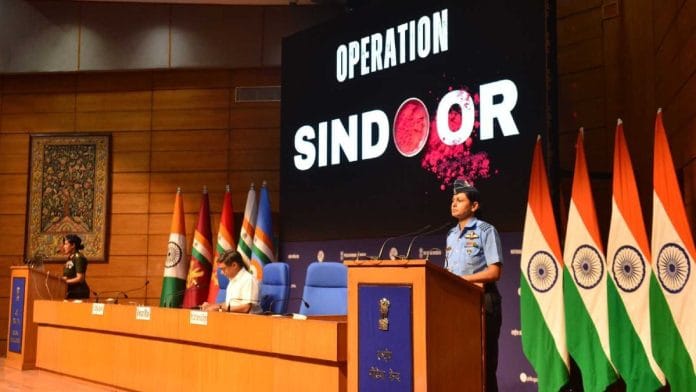New Delhi: Referring to the hostilities between India and Pakistan earlier last month during Operation Sindoor, the latest report of the Stockholm International Peace Research Institute (SIPRI) has cautioned that disinformation and strikes on nuclear-related military infrastructure nearly triggered a serious escalation.
“The combination of strikes on nuclear-related military infrastructure and third-party disinformation risked turning a conventional conflict into a nuclear crisis,” said Matt Korda, Associate Senior Researcher with SIPRI’s Weapons of Mass Destruction Programme and Associate Director for the Nuclear Information Project at the Federation of American Scientists.
“This should act as a stark warning for states seeking to increase their reliance on nuclear weapons,” he added.
SIPRI released its 2025 annual report on the state of armaments, disarmament and international security on Monday, warning that a new and potentially more dangerous nuclear arms race is emerging, even as existing arms control frameworks continue to weaken.
The report highlights AI as both a potential advantage and a major risk. Its ability to process vast datasets rapidly could compress crisis decision-making timelines, increasing the risk of miscommunication, miscalculation or even accidental conflict.
According to SIPRI, India is estimated to have approximately 180 nuclear warheads as of January 2025, a slight increase over the previous year. These are distributed across a maturing nuclear triad comprising land-based missiles, aircraft and nuclear-powered ballistic missile submarines (SSBNs).
It further believes that India’s recent move toward deploying canisterised missiles and undertaking sea-based deterrent patrols may indicate the country’s fresh shift towards mating some nuclear warheads with their launchers even during peacetime.
The assessment believes that India’s Prithvi short-range missile is ‘dual-capable’ and acknowledges that in March 2024, India conducted the first flight test of its multiple independently targetable re-entry vehicle (MIRV) equipped Agni-V under Mission Divyastra.
Meanwhile, as per the report, Pakistan’s estimated nuclear arsenal remains stagnant at around 170 warheads, though “there is a continued development of new delivery systems and accumulation of fissile material, suggesting a potential expansion over the coming decade,” it reads.
“It is developing two versions of the Ra’ad (Hatf-8) air-launched cruise missile, though neither has yet entered service. Its Mirage III and possibly Mirage V aircraft currently serve as delivery platforms, with growing indications that the JF-17 may take over the nuclear delivery role in the future,” it reads. “All of Pakistan’s missiles, including the Nasr (Hatf-9), are believed to be dual-capable.”
However, it adds that there is no certainty on whether all missile bases in Pakistan have been assigned nuclear roles.
As per the assessment, while Pakistan continues to be the central focus of India’s nuclear posture, it points to a growing emphasis in India on longer-range capabilities, particularly those aimed at covering targets across China.
SIPRI identifies China as “undergoing the most significant nuclear expansion” among all the nuclear-armed states. “Its stockpile is estimated to have increased from 500 to 600 warheads in 2024, with at least 132 warheads thought to be assigned to launchers still being loaded”.
The annual assessment further believes that China’s DF-26 intermediate-range ballistic missile is a key dual-capable system offering flexibility in switching between conventional and nuclear payloads and adds, “the CH-AS-X-13 air-launched ballistic missile, reportedly carried by H-6N bombers, to be nuclear-capable.”
As of January 2025, SIPRI estimates that the nine nuclear-armed countries–the United States, Russia, the United Kingdom, France, China, India, Pakistan, North Korea and Israel–together possess approximately 12,241 nuclear warheads.
“Of these, about 9,614 are potentially operationally available, and roughly 3,912 are deployed with military forces, and approximately 2,100 warheads are believed to be maintained at high operational alert on ballistic missiles,” it says.
Although the total number of nuclear weapons worldwide continues to decline due to the dismantling of retired warheads by the United States and Russia, the report warns that the number of warheads in active military stockpiles is beginning to rise. It adds that the annual pace of dismantling has slowed and may soon be overtaken by the rate at which new warheads are being added to global arsenals.
“The era of reductions in the number of nuclear weapons in the world, which had lasted till the end of the Cold War, is coming to an end,” said Hans M. Kristensen, Associate Senior Fellow with SIPRI’s Weapons of Mass Destruction Programme. “Instead, we see a clear trend of growing nuclear arsenals, sharpened nuclear rhetoric and the abandonment of arms control agreements.”
On the future of security, stability and nuclear challenge
The latest SIPRI’s report further underlines that the arms race today is more likely to be “qualitative rather than quantitative”, driven by rapid developments in cyber warfare, artificial intelligence (AI), quantum sensing and space technologies.
Quantum technologies, the report says, are likely to disrupt current cryptographic standards and enable novel forms of global surveillance. “Until now, nuclear-powered submarines were considered virtually undetectable due to the vastness of the ocean,” the report notes. “But quantum detection could challenge that assumption, potentially introducing new sources of instability.”
Development of nuclear missile defence is also flagged as a concern by the assessment. “If it works, it acts as an anti-nuclear shield, removing the fear of retaliation and thus undermining deterrence,” the report warns.
The weakening of arms control agreements remains a key concern in the report.
The report notes that the New START treaty, the last remaining strategic arms control accord between the United States and Russia, is set to expire in early 2026. It adds that there are currently no ongoing negotiations to renew or replace it.
“There are no signs that either side is interested in a successor treaty.”
“The signs are that a new arms race is gearing up that carries much more risk and uncertainty than the last one,” said Dan Smith, SIPRI Director. “The rapid development and application of technologies in AI, cyber, missile defence, space and quantum are radically redefining deterrence and creating new sources of instability.”
(Edited by Viny Mishra)
Also read: China outspends India on defence in 2024, shows SIPRI report. Pakistan far behind






